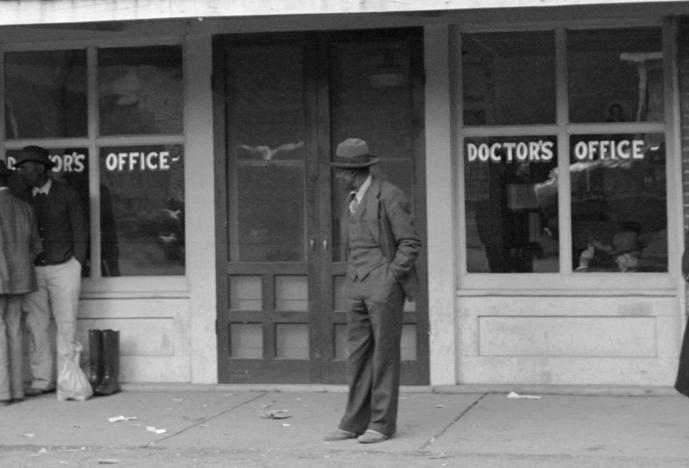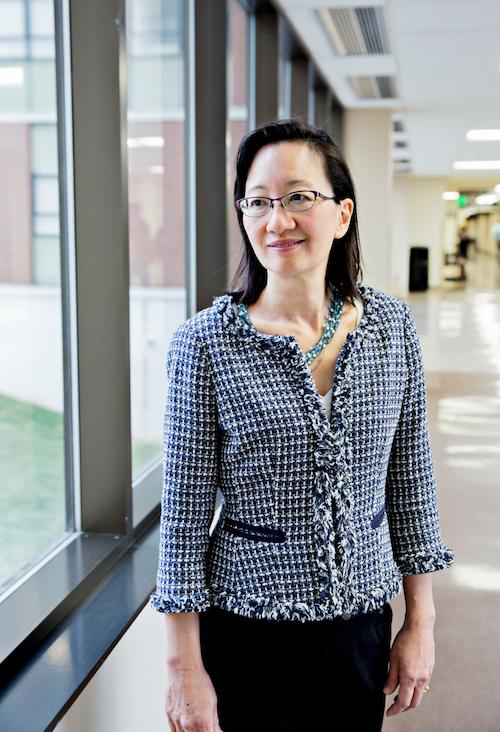(Un)intended Consequences
Unconscious bias hurts individuals on both sides of the white coat
- Feature

Titled “Negroes in front of doctor’s office in Merigold, Mississippi,” this photo was taken in late 1939 by Marion Post Wolcott, a noted U.S. photographer who worked for the Farm Security Administration during the Depression.
Does pain have a color? If, in 1993, you were reading a certain study in JAMA, you might think it did. Or you might think pain manifested differently according to complexion. Why? Well, that JAMA article reported that Latinos with a broken arm or leg were two times less likely to get pain medicine in a Los Angeles emergency department than whites with similar injuries.
But felt pain was really not the issue. The issue was how relief was meted out.
That study was an early ripple in a wave of findings showing an inequity in the delivery of health care. By 1999, Congress was asking the Institutes of Medicine—now the National Academy of Medicine—to investigate the situation. In their 2003 report, Unequal Treatment: Confronting Racial and Ethnic Disparities in Health Care, the authors noted that “racial and ethnic disparities in healthcare … are consistent and extensive across a range of medical conditions and healthcare services, are associated with worse health outcomes, and occur independently of insurance status, income, and education.”
The report’s authors also wrote that while “myriad sources contribute to these disparities, some evidence suggests that bias, prejudice, and stereotyping on the part of healthcare providers may contribute to differences in care.”

A growing body of research has shown that implicit bias, also referred to as unconscious or unthinking bias, is widespread and affects, for example, women, people of color, and those who have disabilities or who are overweight.
Recent studies have found that discriminatory actions based on such biases contribute to poorer health care. In addition, there’s evidence that experiencing short- or long-term discrimination can increase the risk of many diseases throughout a lifetime. Research on medical education itself has shown that unconscious bias can impede academic performance among minorities underrepresented in medicine. It also can impede progress toward diversity in medicine, a goal that leaders in academic medicine say is crucial to ensuring the delivery of quality care to all people.
Test Roles
For a good number of years, researchers have been trying to get a handle on implicit bias: why it develops, how it is expressed, what its outcomes are. Two people who are active in this area of investigation are experimental psychologists Mahzarin Banaji, the Richard Clarke Cabot Professor of Social Ethics in the Department of Psychology at Harvard University, and Anthony Greenwald of the University of Washington Department of Psychology. They developed the implicit association test (IAT), one of the most widely used tests for the measurement of such bias.
In the 2013 book Blindspot, Banaji and Greenwald describe how they developed the IAT. Humans find it easier to sort things into categories that are cognitively connected. People can, for instance, separate red playing cards from black more quickly and with fewer mistakes than they can sort clubs from hearts and diamonds from spades. Building upon this observation, in 1994, Greenwald developed a computer program that presented faces, both Black and white, and words in rapid succession. He then determined the cognitive connections that were made in those who participated.
It turns out that faces of Blacks were more quickly matched with negative words. White faces, by contrast, were more quickly associated with positive words. This biased association persists. In the years since the test was developed, nearly 75 percent of those who have taken the Black-White IAT found it easier to match white faces with favorable words. This response, write Banaji and Greenwald, can best be described as an “automatic White preference.”
Would these results hold if the test population were made up of physicians? To a large extent, yes, according to a 2009 study in the Journal of Health Care for the Poor and Underserved. For this study, a diverse group of more than 2,500 physicians voluntarily took the Black-White IAT online over a two-year period. When analyzed, the investigators found that white, Asian, and Latino doctors showed a preference for whites. Black physicians, however, exhibited no significant racial preference.
To determine whether such preferences played out in the clinic, Banaji and colleagues tested whether scores on the test predicted any differences in diagnosis, referrals for care, or other measurable characteristics of clinical encounters.
In their 2007 paper on this question, reported in the Journal of General Internal Medicine, Banaji and colleagues showed a group of physicians vignettes of Black and white patients who were presenting with symptoms of an acute coronary syndrome marked by impaired blood flow, which can lead to organ and tissue damage. They found that physicians who exhibited a high pro-white bias on the IAT were less likely to refer Black patients for thrombolysis, a treatment that helps dissolve blockages in blood vessels, thus improving blood flow and potentially preventing further physiological damage.
In work published in the American Journal of Public Health in 2012, Greenwald and others found that primary care physicians who exhibit high unconscious racial biases in the IAT tend to dominate conversations with Black patients, often failing to gather sufficient details of the patients’ social and emotional needs. This dynamic leaves patients feeling unengaged and dissatisfied with the care they receive. Lower engagement and satisfaction can themselves have consequences: Research has shown that patients who feel this way and have illnesses such as diabetes and depression are less likely to follow treatment regimens that would control their conditions.
Proof Sheets
“I like to tell my students that I am a prejudiced person, because I think of myself as a normal human being. These are very human processes that occur in all of us,” says David Williams, the Florence Sprague Norman and Laura Smart Norman Professor of Public Health at the Harvard T.H. Chan School of Public Health, professor of African and African American Studies, and professor of sociology at Harvard University.

Williams, who was part of the team that wrote Unequal Treatment, is internationally recognized as a leading social scientist who focuses on social influences on health, and, in particular, the ways in which race, racism, socioeconomic status, stress, health behaviors, and religious involvement can affect physical and mental health.
In 1995, Williams developed a tool that has provided arguably the best insight into how daily discriminatory acts create burdens for individuals. Known as the Everyday Discrimination Scale, the test consists of a series of simple statements designed to measure the types of and frequency by which a test taker has experienced discrimination. Sample questions give an idea of how the tool probes the issue: are you treated with less courtesy than other people; do people act as if they think you are not smart; are you called names or insulted. If the person taking the test encounters even one situation with a frequency that could range from daily to at least a few times a year, the test taker is asked what might be the reason for such experience. Test takers are also asked to identify themselves using categories that include race, gender, and sexual orientation.
“These measures,” says Williams, “capture the impact of little conflicts and little indignities.”
Williams notes that researchers have found that people who report high levels of everyday discrimination have elevated levels of coronary artery calcification, blood pressure, inflammation, and sleep problems; more rapid decline in cognitive function during aging; and premature mortality.
The effects accumulate over a lifetime, Williams notes, so that experiencing success later in life doesn’t erase the damage done during years of childhood adversity. As an illustration of Williams’ point, a 2012 study by a research team that included Herman Taylor ’80, leader of the Jackson Heart Study from 1999 to 2014, found that among participants in that landmark assessment of cardiovascular risk within Black populations those with a high lifetime burden of perceived discrimination exhibited high levels of hypertension.
Sometimes biased diagnoses are a result of flawed research protocols. According to Taylor, who is also the director of the Cardiovascular Research Institute at Morehouse School of Medicine, one way to fix this is to encourage physician-researchers to consider the members of the communities they serve to be equal partners. The Jackson Heart Study is evidence for his point: its participants are “empowered” participants, not passive subjects.
In addition to revealing crucial details about how factors such as social discrimination, genetics, and other influences contribute to cardiovascular disease in Blacks, Taylor said in a recent presentation that the study is beginning to yield insights about characteristics that contribute to good heart health.
Here, again, bias can make it hard to see the important details.
“It’s not all deprivation when you talk about African Americans,” says Taylor in an online presentation, citing the importance of social connections, community relationships, and neighborhoods within Black communities.
According to Taylor, these and perhaps other yet-unidentified factors may be reasons behind the fact that many Blacks live long and well, despite facing social inequities that are known to have negative health effects.
“The secret to ending disparities and improving health overall,” says Taylor, “may lie in not only understanding and ending the effects of deprivation and challenge but also in discovering and applying the promoters of resilience in the face of adversity.” Acknowledging and studying good outcomes among Blacks is often neglected, he adds, though they may be critical for revealing new approaches to improved health despite seemingly intractable social inequities.
Deep Focus
Searching for a neurological link to implicit bias has led researchers to use techniques such as functional magnetic resonance imaging (fMRI) to determine which areas of the brain activate when presented information on people we might consider different from ourselves and people we might consider similar.
In a 2000 paper in the Journal of Cognitive Neuroscience, Banaji and colleagues presented findings addressing this question. Banaji’s team measured activity in the amygdala of white participants whose degree of unconscious bias had been measured using the Black-White IAT. The amygdala is the region of the brain that triggers autonomic responses to fear.
The researchers found that if a white person with a high degree of unconscious bias was shown faces of unfamiliar Blacks, activity in the amygdala was heightened. But the amygdala in these participants remained quiet when they were shown the faces of well-known and positively regarded Blacks.
“These data,” Banaji and colleagues wrote, “show for the first time that representations of social groups that differ in race evoke differential amygdala activity and that such activation is related to unconscious social evaluation.”

When we are aware of the possibility of implicit bias and take the time to think consciously, we can overrule the automatic processes. But in fast-moving, complex situations, the brain handles much of the processing in the blink of an eye, Williams says. A busy white doctor meets a new Black patient, for example. Each has just a few moments to react to the other in what is admittedly a stressful environment. Perhaps unconscious bias on the part of the physician manifests as body language that the patient translates as distrust. This feeling causes the patient to withdraw, a behavior the doctor interprets as a lack of cooperation. Alternatively, the doctor may unconsciously associate negative racial images with the patient and provide poorer quality of care without ever intending to do so.
Perspective
To reset or mitigate unconscious bias in the coming generations of physicians, many medical schools are teaching culturally responsive care. The importance of this movement was underscored when the American Association of Medical College’s Liaison Committee on Medical Education made such courses a part of the accrediting standard for cultural competence and health care disparities. The rationale for the requirement stated that medical schools must provide “opportunities for medical students to learn to recognize and appropriately address gender and cultural biases in themselves, in others, and in the health care delivery process.”
A 2015 study in the Journal of General Internal Medicine suggested that, overall, the medical school experience has a mixed effect on unconscious bias in students: Raising awareness about such bias has been found to slightly reduce bias over the four years of medical school. Other training experiences, however, such as students hearing clinical instructors stereotype patients and experiencing negative interactions with others, appear to increase unconscious bias in some cases.
Research published this year in Teaching and Learning in Medicine found that the content of a question bank for Step 1 of the United States Medical Licensing Examination could contribute to the development of implicit bias. The researchers found that race was often used in the questions as a routine demographic variable, but without the social or genetic context necessary to make it a useful clinical descriptor. In addition, whites were overrepresented in the question bank compared to their percentage of the U.S. population. Furthermore, in most examples with white subjects, race did not play a central part in their clinical case.
In questions about Blacks, the person’s race was often described as if it were a key factor in the clinical case. For example, the authors noted, people with sickle cell disease in the question bank were always Black, even though the disease is endemic in parts of Greece and India, while many regions of Africa have low prevalence of the illness.
Falsely promulgating the idea that illnesses such as sickle cell disease, cystic fibrosis, or lactase deficiency are related to a particular race, say the researchers, “risks conveying essentialist, genetically based notions of race and ethnicity to students, which could contribute to bias in clinical practice.”
Focal Point
Understanding implicit bias and using that understanding to inform the development of an inclusive environment is fundamental to how Vivian Lee ’92, guides the work of her leadership team. Lee encourages members of her team to think about their own biases as part of developing an inclusive environment.
“Unconscious bias is common,” reports Lee, CEO of University of Utah Health Care in Salt Lake City, dean of the University of Utah School of Medicine, and senior vice president, university health sciences at the University of Utah, in an email. “I like to encourage people to test themselves. It’s a very revealing experience for most people.”
Taking the IAT itself doesn’t eradicate bias, Lee adds, but it helps raise awareness so that people and institutions can create processes or take measures to reduce its effect when recruiting new leaders for the school or interviewing prospective medical students.
Why does Lee make this a strategic imperative for her organization? She gives two reasons: the community of patients, students, and trainees that the school and its professionals serve is diverse; and diverse perspectives lead to better problem-solving, especially complex problems like those that challenge many academic health systems.
“I think that while most people initially are drawn to others like themselves,” writes Lee, “working in a diverse environment is truly more stimulating and rewarding over the long term. We all learn from each other and that makes for a more fulfilling, productive experience, even if sometimes it feels more challenging.”

Wide-Angle Shot
The current generation of students is continually engaged with questions of race and social justice as a result of heightened consciousness, media exposure, and activism, says André Churchwell ’79, chief diversity officer at Vanderbilt University School of Medicine.
“It’s not just on social media,” Churchwell says. “These are real situations that happen in the hospital and that you have to deal with.”
Churchwell says that he is leading Vanderbilt to embrace a holistic approach to addressing the challenges of bias and social justice. Integrating race consciousness into every aspect of biomedical research and care delivery is important not because it is so-called politically correct language, but because it’s medically and scientifically correct, Churchwell adds.
To illustrate the point, Churchwell describes Andrew Jones, a persona created to demonstrate how the different aspects of race and diversity intersect to influence the health of a patient.
Andrew is a young man with asthma who visits the emergency department often in the summer with acute asthma attacks. A harried ER doctor might assume that Andrew is the kind of kid who doesn’t take his medicine on time or follow his doctor’s advice and earns return trips to the hospital through irresponsible behavior.
But if you look a little deeper, Churchwell says, you might find that Andrew has a genetic susceptibility seen in the Black community that increases sensitivity to the kind of pollution that worsens in Andrew’s neighborhood in the summer, when breezes blow in ozone from nearby refineries.
You need to understand your individual patients in their particular social and environmental context, and you need to understand their illnesses at the genetic and molecular levels, Churchwell says. Then, if you multiply Andrew by 20,000, your understanding expands from a single young man to a community that has its own historical and political context.
“As you try to engage with people, don’t think about them as stereotypes,” Churchwell says. “As we look at the environmental, cultural and social determinants of health, we must also look inward to combat our own biases.”
Jake Miller is a science writer in the HMS Office of Communications and External Relations.
Images: John Soares (Williams, Taylor); Kim Raff (Lee); Abigail Bobo (Churchwell)